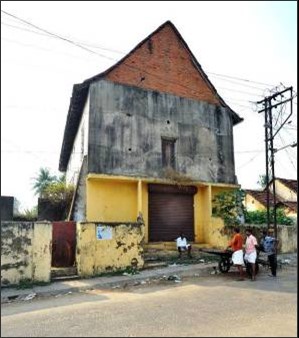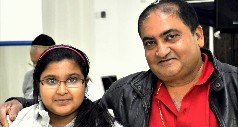KADAVUMBAGAM SYNAGOGUE (Mid-16TH century, but much altered over the years)
Synagogue Lane / Jews Street
Mattancherry, Jew Town
Kochi
Kerala, INDIA
This former synagogue, once a very attractive and elaborate space but altered if not butchered over time (including the now-missing gatehouse and breezeway) and today in ruins, has not been operational for six decades. The building has been sold and resold several times, and a heritage plaque posted (by the author of this website) adjacent to the property was removed by the hostile current owner. Access to the inside of the building is rarely possible, yet a visit to the building is encouraged since the famed Paradesi Synagogue is located conveniently just down the same street. When asking locals about this building, all will think visitors are referring to the Paradesi Synagogue, so beware. There is no contact information or email for this site. For additional assistance about this former synagogue, review cochinsyn.com and contact the author of this site, Jay A. Waronker at This email address is being protected from spambots. You need JavaScript enabled to view it..
Kochi’s (formerly known as Cochin’s) Jew Town in Mattancherry was a dynamic enclave of Jewish life for centuries. Three synagogues anchored Synagogue Lane, surrounded by Jewish schools, homes, and businesses. Hundreds of Jews lived, worked, prayed, were educated, socialized, and celebrated life-cycle and holiday events here, representing one of India’s and the world’s long-standing Jewish centers Muslims, Hindus, and Christians also lived here, but the neighborhood was known as a Jewish district. The Jewish community was never homogenous; individuals from unique Jewish cultures arrived in Kerala at different periods and from a handful of countries. They may have all shared a religion and common interests, but they did not function as one communal group. Here you have the Kadavumbagam synagogue; close by you will find the Paradesi (Foreigners) Synagogue, and the now-demolished Tekkumbagam synagogue is almost immediately to the south. The Kadavumbagan and Tekkumbagam synagogues buildings served the Malabari (name taken from the local region) Jews of Kerala for centuries, and both closed in 1955 when their congregations immigrated en masse to Israel.
A portion of the former Kadavumbagam synagogue still stands today and can be seen from the road, but the building has been privately owned for more than fifty years, and over time considerable modifications and damagess were made to its original design. Its name comes from its location; in Malayalam, kadavu means landing place and bagam means side. When a stretch of Jew Street running in front of the Kadavumbagam synagogue was altered at some point in the 1960s, its two story gatehouse and the connecting breezeway to the rear were demolished. Today the only portion of the former synagogue compound still standing is the sanctuary building.
The early history of the Kadavumbagam synagogue is unclear. A local source refers to a synagogue built here as early as 1200, ruined, and then rebuilt by mudaliyar (Jewish community leader) Baruch Levi in 1539. Another narrative indicates that the synagogue was established in 1130, and its name was taken from a synagogue that existed in Cranganore. Oral stories have recounted that it was built in 1400 when Jews abandoned the nearby Kochangadi synagogue just south of Jew Town (yet this did not happen historically until 1795), that it was ruined, and then rebuilt around 1530, or that three local Jews were responsible for its construction from 1539 to 1544. In 1549, it is said that the Kadavumbagam synagogue was completed by Yaakov ben David Castiel, the brother and father of the third and fourth mudaliyars. Another source offers a slightly different history, that in 1539 the building of the Kadavumbagam synagogue was begun, and that it was completed by Barukh Joseph Levi who had restored the Cochangadi synagogue. The Kadavumbagam synagogue was extended or restored in 1549 by Jacob David Castiel.
Enough of the Kadavumbagam synagogue remains standing today to recognize it as a quintessential example of vernacular Kerala architecture for its materials, construction technique, and massing. In response to the climate and annual monsoons and drawing from locally available materials and regional construction techniques, the building features a steeply sloped clay tiled roof with deep, open eaves that are set on wooden rafters. The roof framing system is supported by load bearing walls made of hand-cut laterite stone blocks that are veneered with chunam (lime). Although many of them have now been altered or removed, the synagogue’s thick walls were punctured by large wooden windows and doors with transoms and shutters providing natural light and ventilation to the inside.
When the Kadavumbagam synagogue was fully intact and before the surrounding area was altered, there was an open space directly across the synagogue compound which extended east to the nearby water. In years past, according to a narrative, the Rajah of Cochin would set sail in a private boat from his Dutch Palace (built by the Portuguese to honor the rajah and upgraded during the Dutch period) at the northern end of Jew Town just beyond the Paradesi synagogue. Whenever his Highness was about to travel southward and pass the Kadavumbagam synagogue, news of his voyage would reach the congregation. Someone from the community would open the doors of the gatehouse, those of the azara in front of the sanctuary, and finally the heckal which, in Kerala synagogue tradition, were all on a longitudinal axis. The rajah’s boat would pause at the landing, offering him a clear vista from the water, across to the shore, through the gap between neighboring buildings towards the synagogue and all the way through the spaces of the building to the end point: the Sefer Torah scrolls. According to this tradition, the Rajah of Cochin would then stand and prostrate himself towards the synagogue.
Although the Kadavumbagam synagogue is today the most compromised of Kerala’s surviving synagogue buildings, photographs reveal that it was an attractive building. The synagogue complex’s main entrance was originally through a broad gatehouse. Like the sanctuary building, it too was two floors, featuring a steeply gabled roof, but it was a considerably lower massing. In front of the gatehouse entry doors was a small open portico that served as a transition and a protection zone. The lower level of the entry building/gatehouse likely included a talem, or anteroom that could be used for community and meeting spaces, as well as a stair. Its upper floor had rooms used as a Jewish school. A breezeway was on an axis with the portico and entry doors and connected to the rear of the gatehouse.
When intact and in its prime, the Kadavumbagam synagogue was notable for its exterior ornamentation and painted surfaces, specifically at the gabled end of the sanctuary building. The interior of building was also unique among other Kerala synagogues for its particularly elaborately carved and painted woodwork. All the applied decoration that once covered the gable end and made the Kadavumbagam synagogue unique has long been removed and lost: the painted wall surface pattern along the rake, a pair of shallow engaged pilasters, an attic window and the ornamental panel filling the area at the apex of the roof. The panel featured a border of tightly spaced crenellations below the rake line and a crown positioned at the apex of the triangle. Dangling from the base of the crown was a twisted and looped rope. Below that was a band of trim in a half octagon shape surrounding a Hebrew inscription. A carved wood filigree fascia board also once graced the sanctuary’s gabled end as a rake cornice.
While the gatehouse and breezeway no longer stand, the synagogue’s main building containing the azara (foyer), sanctuary and women’s seating area remains, although in derelict form. Although the original entry sequence into the azara has been changed, the space itself remains, stripped of its finishes and in poor condition. The azara gets it name from the outdoor courtyard area that existed in the ancient Jewish temple in Jerusalem and is mentioned in the Jewish Talmud.
At the time of the Kadavumbagam community’s immigration to Israel in 1955, the synagogue was handed over to the Bombay Jewish Agency under the care of a Paradesi Jew. Just before the community left Kochi, the heckal was removed from the sanctuary, and it too traveled to Israel. The Kadavumbagam émigrés were unable claim it from customs, so it was eventually taken to the synagogue in moshav Nehalim, an agricultural community in central Israel, there it has remained ever since. After sitting for some years, the Kadavumbagam synagogue was rented out as a coir storage facility. In 1981, a trading company purchased the building. Ten years later, the former synagogue was again sold. Its new owner arranged for the sale of the interior of the synagogue, including the intricately carved gallery with its unique second tebah, finished ceiling, doors, all trim and casework, fittings, and any remaining furnishings, to Mr. Fred Worms of England, who had the items shipped to the Israel Museum in Jerusalem,there they were restored and reassembled for display. Similar details can be seen throughout Kerala in mosques, churches, palaces, and other important buildings of the same period. In the center of the guardrail, supported by the two wooden columns found in all Kerala synagogues, was the bowed-out second tebah, a unique liturgical feature to synagogues. Following the tradition of synagogues in Kerala, the women’s seating area was placed behind the balcony. The space was separated from the gallery and its second tebah by a mechitza, or screened partition.

Exterior

Interior








